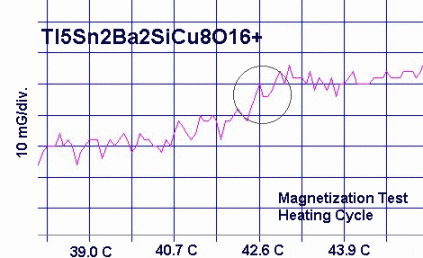
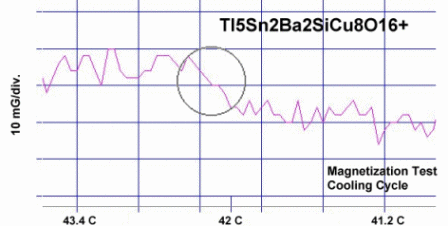


Superconductors.ORG herein reports the 38 C superconductor discovered in July 2013 has been reformulated to produce a Meissner transition near 42 Celsius (107F, 315K). This was accomplished by substituting tin (Sn) into the lead (Pb) atomic sites of the D212 structure (shown below left), changing the formula to Tl5Sn2Ba2SiCu8O16+. Multiple magnetization plots clearly show diamagnetic transitions consistently appearing about 4 degrees higher than with Pb in the same atomic site(s). This is the seventh material found to superconduct above room temperature.1
Since 2005 improvements in superconductor Tc's have resulted from increased planar weight ratios (PWR) along the C1 and C2 axes. However, the structures of recent discoveries are nearing the upper limit of 33 angstroms along those axes. And, without looking to the Actinides for new possibilities, there are few elemental combinations remaining that can increase PWR further. So a different approach was taken to increase Tc: focus was shifted to the elasticity modulus.
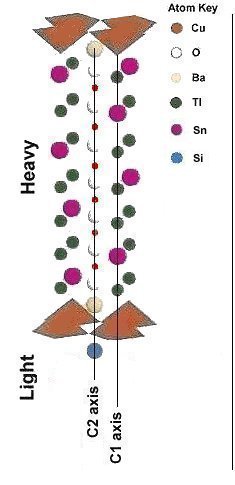
|
By substituting two tin (Sn) atoms into the two lead (Pb) atomic sites, the PWR drops, but Tc increases. This seems counter-intuitive, considering that more than 60 new superconductors have been discovered by increasing PWR. The low elasticity modulus of Pb appears to be suppressing lattice vibrations below optimum. Substituting divalent tin maintains the same 28% hole-doping of the insulating layers, while providing for a much higher elasticity modulus of 50 (vs 16 for Pb). 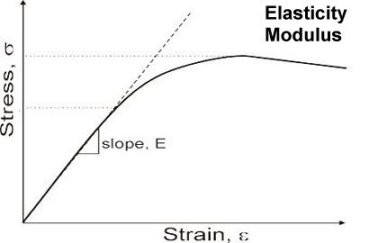
Since an abundance of evidence supports lattice vibrations as a key component of high-temperature superconductivity, it follows that the elasticity of the lattice should also correlate with Tc. To quote Hyper-Physics at GSU: "The bulk modulus of a solid influences the speed of sound and other mechanical waves in the material. It is also a factor in the amount of energy stored in a solid." |
Of eleven unambiguous magnetization tests, the transitions ranged from a low of 40.8 C (shown below left) up to a high of 43.5 C (shown below right). The average of all the tests was just over 42.1 Celsius.2
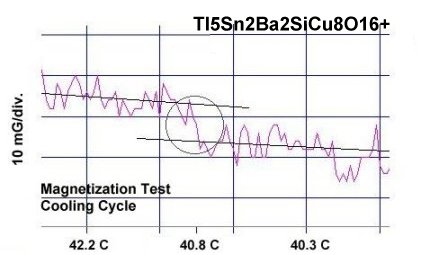
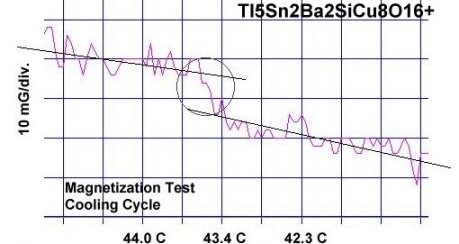
The below plot shows how Tc has increased in proportion to the planar weight ratio along the (heavy) C1 axis. This trend continues until about 300 K, after which electron-doping and elasticity modulus skew the curve.
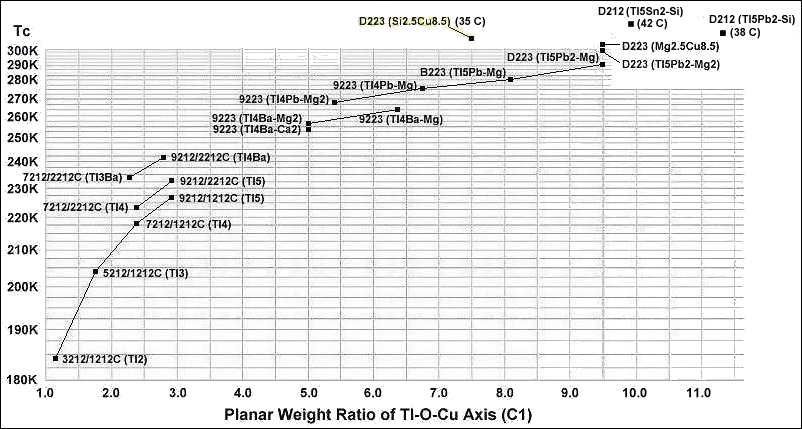
Tl5Sn2Ba2SiCu8O16+ was prepared using the layer cake method, as shown below. The pellet had over 100 interference layers. And, even using this layering technique, the volume fraction is low, requiring very sensitive test equipment.
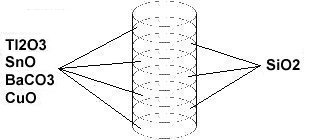
The below stoichiometric ratios were used for the ODD layers:
Tl2O3 99.99% (Alfa Aesar) 5.60 grains...and the below ratios for the EVEN layers.
SiO2 99.996% (GE 214) 5 grains (non-critical)The chemical precursors were pelletized at 60,000 PSI and sintered for 34 hours at 860C. The pellet was then annealed for 10+ hours at 500C in flowing O2. Temperature was determined using an Omega type "T" thermocouple and precision OP77 DC amplifier. The magnetometer employed twin Honeywell SS94A1F Hall-effect sensors with a tandem sensitivity of 50 mv/Gauss.
RESEARCH NOTE: The copper-oxides are strongly hygroscopic. All tests should be performed immediately after annealing.
RE-PUBLICATION NOTICE: Elsevier Publishing, dba Elsevier Science, as well as Morris Communications, both print and broadcast divisions, are specifically prohibited from re-publishing any part of this news story.
E. Joe Eck
© 2013 Superconductors.ORG
All rights reserved.
1. Materials 5, 6 and 8 have not yet been published, pending patent application.
2. Testing temperatures are believed accurate within +/- 0.50 degrees C.
 BACK to "News" page at Superconductors.ORG
BACK to "News" page at Superconductors.ORG